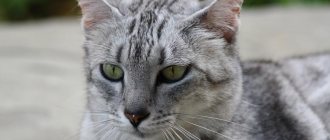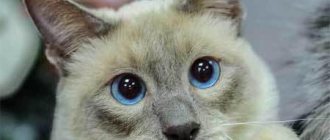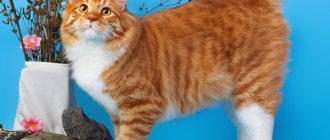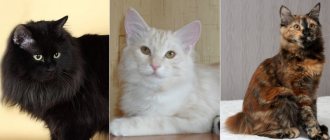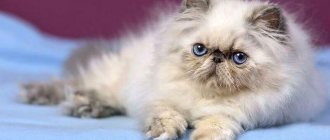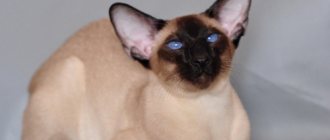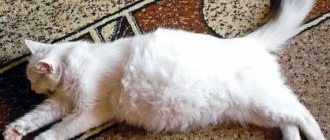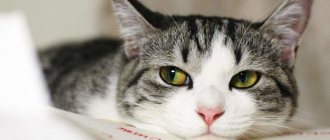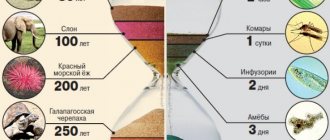Description of the Karelian Bobtail breed
The Karelian Bobtail is a small breed of cat, with a short tail from 4 to 13 cm. The average weight for males is 4-6 kg, for females it is 2.5-4 kg, males also exceed females in size.
- The head is narrow, has a wedge-shaped skull and large erect ears with small, barely noticeable tassels. The forehead is flat. The muzzle is without cheeks, the whisker pads are barely noticeable. The chin is small and strong.
- The eyes are medium in size, oval in shape and slightly slanted.
- Body: the back is straight, the croup is slightly raised, as the front legs are slightly shorter than the hind legs.
- The legs are slender and muscular, the paws are round and wide.
Karelian bobtails come in two types: shorthaired and longhaired (semi-longhaired). The undercoat is short and dense. The long-haired ones have “pants” growing in the area of the hind legs, and a shirtfront on the neck. But shorthairs have thicker and more beautiful hair.
The color of the animal may be the most unusual. Breeders identify several primary colors, which are mixed together into unusual combinations (bicolor, tricolor, tabby):
- Ginger;
- Grey;
- Black;
- White.
In this species, individuals of only one color are rarely found, since “camouflage” colors are common among them, for more convenient and inconspicuous hunting.
Coat color
The color is very diverse, including bi- and tricolor. Exceptions are the color of Siamese cats, such as "fawn", chocolate brown, cinnamon, blue.
Ultrasound of animals. Why is it made?- Where can I take veterinary courses and what are they for?
Akita Inu. What kind of breed is this and what are its characteristics?
Character
Cats of this breed adapt well to any living conditions, although they have a freedom-loving and independent character. This is due to the fact that in nature they live in prides, where they have their own hierarchy, as well as the need to coexist with relatives.
That’s why they quickly get used to a person and value his love and affection very much, but they rarely give in to their arms. A big advantage of the character of these cats is that they do not remember insults, and therefore are perfect for families with small children.
- Karelian Bobtails retain their youthful character for a long time, and even at age they are active and playful.
- At the same time, cats are very smart and with proper training can be very obedient.
- There are no conflicts with other animals, since they do not see the need to divide the territory or mark it.
- They treat strangers calmly, without aggression.
Since bobtails have a very thick undercoat, they tolerate low temperatures and drafts well. Therefore, they can be taken for a walk at any time of the year.
Origin story
The first standard for the Karelian Bobtail breed was written in 1987 by the breeding commission of KLK Kotofey in St. Petersburg. The model was the breeding cats of Liliya Dvoryanovich.
The short tail of the bobtail is the result of a natural mutation that occurred with one or more animals in the vastness of Karelia, and then was passed on from generation to generation. Felinologists have reason to believe that Norwegian forest cats played an important role in the formation of Karelian bobtails.
The final standard was recognized by the WCF in 1994. The population of Karelian bobtails is very small and consists mainly of tailless yard cats living in their historical homeland, as well as in the Arkhangelsk, Murmansk, Leningrad regions, in Finland and in several nurseries.
There aren’t even any photographs left of Dvoryanovich’s nursery or pets. Enthusiasts have made several attempts to revive the breed, but all are in vain. Since 2012, work on the restoration of Karelian Bobtails began again with the initiative of Alla Kozlova (kennel “Sampo Ilveksen”, St. Petersburg). For 2021, 3 nurseries have already been registered that are engaged in breeding cats of a rare native breed.
It is proposed to change the name of the breed in the near future to eliminate confusion between the Karelian and Kuril Bobtail breeds.
Video about the Karelian Bobtail cat breed:
Care instructions
Caring for Karelians is standard and is no different from caring for other breeds.
- Wool. They should be brushed every week, and during the shedding season from 2 to 4 times, depending on the length of the coat. Use special brushes with natural bristles or rubber combs.
- Bathing. Like all bobtail cats, they do not like to take a bath, but it is necessary several times a month. When bathing you need to use special shampoos.
- Eyes. You need to wipe your eyes every day, while moistening a cotton pad with water, tea leaves or chlorhexidine.
- Ears. You need to clean your ears once a month with a regular cotton swab or gauze.
- Claws. You can get a special scratching post for your pet, but if you don’t have one, you will need to trim it every month. This can be done using nail scissors or a nail clipper.
- Tray filler. You can choose absolutely any one, the main thing is to clean the tray on time, since bobtails are very squeamish.
What is also important is that your pet needs its own sleeping place.
This breed pays special attention to sleep, and therefore its bed should be in a certain place and preferably with a roof, so that the animal can hide and rest.
Dietary recommendations
Most animals are not picky about their diet; they can eat both natural food and feed. It is important to know here that you should never mix these types of diet!
A natural menu should include products that will meet the need for vitamins and microelements in your pet’s body. The basis of the menu should be meat, since it makes up 80% of their food in nature.
Recommended diet
- Raw or boiled meat (beef, chicken, veal, rabbit, lamb or turkey);
- Lean sea fish (hake, flounder, trout);
- Eggs: boiled chicken yolk, raw quail and goose;
- Fermented milk products (cottage cheese, kefir, yogurt, Varenets sour cream, natural yogurt, hard unsalted cheese);
- Steamed or stewed vegetables (carrots, zucchini, asparagus, broccoli, pumpkin);
- Apples, blueberries, cranberries and greens;
- Vegetable oil (sunflower, olive, flaxseed);
- Porridge (oatmeal, semolina, pearl barley, rice, buckwheat).
Prohibited diet
- Smoked meats;
- Bones (raw, cooked);
- Garlic, onion;
- Eggplants and tomatoes;
- Flour;
- Semi-finished products;
- Sweets and chocolate;
- Fatty meat and lard (pork, goose);
- Spices, marinades, sauces.
When choosing dry and wet food, you must remember that colored packaging and catchy advertising do not make the food good. Therefore, it is important to understand what your pet eats.
Diet features
Most often, owners of four-legged animals prefer dry types of food. But they are not considered the only correct ones. Such cats feel great on a natural diet. They do not go overboard with food, but they begin to act up if you pamper them.
The diet should always include lean meat in the form of rabbit, poultry, and beef. Eggs, fermented milk products, and sea fish will be beneficial. As for the daily norm, it is calculated based on the general condition of the pet, its physiological and age-related needs (lactation or pregnancy, sterilization or castration). Exceeding the permissible dosages will inevitably lead to obesity with the subsequent development of serious pathologies.
Diseases and treatment
Karelian Bobtails have good, strong health, so illnesses are rare among them, as well as a genetic predisposition to any types of diseases and pathologies.
With proper care, a pet can live up to 20 years. However, it is important to remember that timely vaccination of domestic cats can help avoid many problems.
Basic vaccinations that Karelians must receive:
- Chlamydia;
- Rabies;
- Calicivirus;
- Feline distemper;
- Rhinotracheitis;
- Infectious peritonitis.
The list of vaccinations can be expanded, it depends on the bobtail’s lifestyle.
The normal body temperature of a cat is 37-39 degrees; if it rises to 40, then you must immediately contact a specialist, since such a temperature indicates the animal is hot and is extremely critical for it.
When the first symptoms of illness appear in your pet, you must provide him with free access to fresh, not cold water and contact the nearest veterinary center.
Varieties of Wild Forest Cat
The wild forest cat includes 23 subspecies, including, in particular:
- Central European Felis silvestris silvestris;
- Caucasian Felis silvestris caucasica;
- Turkestan Felis silvestris caudata;
- Omani Felis silvestris gordoni;
- Steppe Felis silvestris lybica;
- African subspecies Felis silvestris cafra;
- Chinese Felis silvestris chutuchta;
- Domestic Felis silvestris catus.
Mating
Karelians reach sexual maturity in the first year of life. However, it is recommended to breed them when they reach 1.5 - 2 years of age, and always only with relatives, since mating with other species can end badly. It is better to conduct the meeting on the male’s property.
Before a planned pregnancy, a cat should not be bathed so as not to disturb its scent, which is so attractive to the male. After conception, it is necessary to maintain a certain diet to maintain the mother’s body.
Since the females of this species are in good health, pregnancy and childbirth are easy for them. However, at birth it is best to have a veterinarian present to assist.
They make the best mothers and never leave their babies for a moment, protecting and protecting them. If there are a large number of babies born, it is better to organize additional complementary feeding so that the little kittens’ bodies are properly formed and there are no health complications in the future.
Health of Karelians
What else bobtails can boast of is excellent health. Inherited from their wild counterparts, they received not only a shortened tail, but also resistance to various diseases and strong immunity. But sometimes illnesses still occur. Regular walks in the fresh air, which have a beneficial effect on your pet’s well-being, will help prevent frequent visits to the veterinarian. A balanced and properly organized diet is important. In such conditions, bobtails from Karelia can live 15 years or more.
Kittens
Adopting a Karelian Bobtail kitten is incredibly difficult, since this species is very rare. Therefore, the choice of a little friend must be approached with the utmost seriousness. Before purchasing, it is best to visit exhibitions and talk to breeders.
Find out all the information about parents, diseases, living conditions and nutrition. It is also recommended to examine all kittens born in the litter. All animals must be well-groomed and active.
When choosing a pet, you need to pay attention to the following criteria:
- Ears, eyes and nose without discharge;
- The skin under the fur is free of redness, rashes and wounds;
- The mucous cavities have a uniform pink color;
- The animal is not thin, the belly is round, but not bloated;
- The anus is clean and without cracks.
After purchasing the kitten, the breeder must provide the following documents:
- Passport confirming the breed;
- Veterinary card with vaccinations.
But if a breeder offers to buy a bobtail kitten with a share, it means that this is a deception, since the cat receives a pedigree only after the first independent exhibition.
The price of a Karelian bobtail baby ranges from 15 thousand rubles. — 40 thousand rubles. Such a large range depends on what the Karelian is purchased for, so if you want to acquire a champion, you will have to pay a fairly large amount for the purchase.
Interesting facts
- Cats of this breed have habits that are characteristic of dogs. They protect their territory by making rounds and checking for changes.
- Karelians have lively facial expressions and can make an upset expression on their faces if they are offended by something.
- When jumping, these cats push off with all their paws at once, not just two, as all cats do.
- Males of this species do not have a predilection for marking territory.
- Bobtails are very sensitive cats, and therefore if tension is felt at home, they try to smooth it out and cheer up their owner.
- These tailed animals choose only one owner, usually this is the person in whom they feel the leader.
- Since ancient times, settlers of the Karelian Isthmus believed that this breed brings good luck and happiness.
